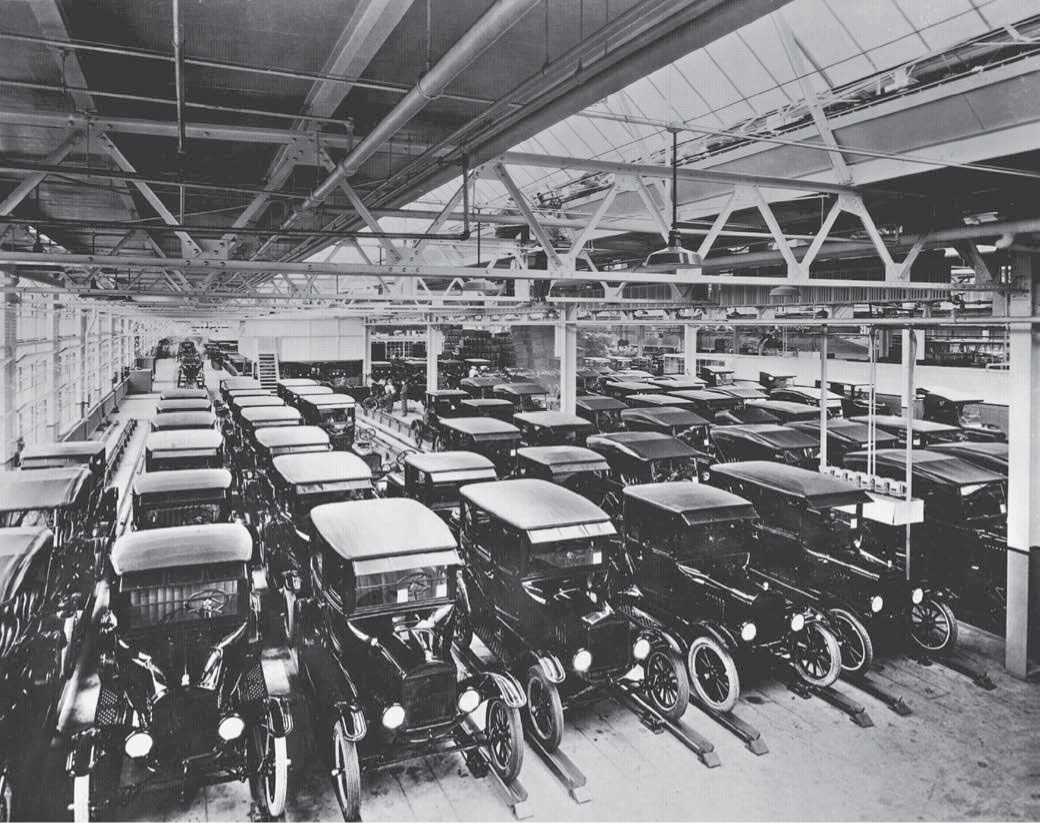The emergence of the automobile industry in the early 20th century had a dramatic impact on American society. Perhaps no other technological invention has so fundamentally altered the way ordinary Americans lived. Important innovations in the production of automobiles took place between 1860 and 1890, but it was the introduction of mass production and widespread automobile ownership between 1900 and 1930 that had the greatest impact. Prior to 1900, automobiles were handcrafted one by one. These early automobiles were unreliable and very expensive. The early automobile industry was centered in the region around Detroit, Michigan and Toledo, Ohio, in part because that was where the bicycle industry was located. Early automobiles incorporated much of the technology used in the bicycle industry and employed the industry’s skilled machinists. By 1900, dozens of small automobile manufacturers were springing up in Detroit. Many of these early manufacturers, including Henry
Ford, built automobiles only after they had received an individual order.
Automobiles began to be mass produced in the first decade of the 20th century. The introduction of precision-made, interchangeable parts and assembly-line labor between 1900 and 1910 allowed manufacturers to increase production. From the beginning, demand for the automobile was widespread. In 1900, Americans owned 2,500 automobiles, and by 1910 the number had jumped to over 450,000. Automobile manufacturers attempted to meet this demand through mass production. First attempted by Ransom E. Olds, it wasn’t until Henry Ford introduced the Model T Ford in 1908 that a reliable automobile became affordable for the average citizen. The no-frills Model T came in only one color (black) and cost a modest $850. Its popularity was phenomenal. Between 1908 and 1927, the Ford Motor Company sold 15 million Model Ts. The key to Ford’s success was his ability to automate virtually every aspect of the automobile’s construction and to continually find quicker and more efficient methods of production. With the opening of the Highland Park plant in 1910, Ford was able to reduce the time it took to produce an automobile from 728 minutes to 93 minutes. The more cars Ford produced, the cheaper they became, and the more he sold. Ford dominated the auto industry between 1910 and 1920. Sales of Ford automobiles doubled nearly every year, from 13,840 in 1909 to 189,088 by 1913.
Although Ford quickly emerged as the dominant automobile manufacturer, he had many competitors. In 1908, the year Ford introduced the Model T, there were more than 50 manufacturers. That same year William C. Durant formed the General Motors Corporation (GM). Unlike Ford who was obsessed with creating a utilitarian automobile, Durant dreamed of controlling the industry and creating expensive luxury cars. Between 1908 and 1910, he bought out 11 competing automakers, including Cadillac, Buick, Oldsmobile, and Pontiac, but his spending spree left General Motors virtually bankrupt. The fortunes of the company changed when Alfred P. Sloan took control in 1923. Under his direction, General Motors attempted to increase sales and market share by making its automobiles stylish. The company hired artists and designers and sold cars in many different makes, models, and colors. As automobile ownership became more common, consumers placed increased importance on style and design. As competition over sales increased, other innovations took place as well. These included safety features and larger and more powerful engines. Sloan hoped that by constantly changing model styles and colors and introducing new features, consumers would buy new cars more frequently. They would want to buy the latest model and gadget. By 1930, GM was introducing new models every year. Ford, however, steadfastly refused to follow suit. When Ford refused to offer the Model T in any other color than

Row of completed "Tin Lizzies," or Model Ts, come off the Ford assembly line. (Hulton/Archive)
Black and resisted other design changes, GM was able to dramatically increase its share of the market. By 1930, it had become the largest automobile manufacturer in the country. GM, Ford, and the Chrysler Corporation (formed in 1925) had become large and powerful enough that they were able to produce higher quality automobiles at lower prices than their competitors. One by one, medium-sized car manufacturers were either forced out of business or bought out by the Big Three automakers.
The emergence of the auto industry had an important impact on labor-management relations. The industry’s growth meant that hundreds of thousands of workers were now employed by the auto manufacturers, parts suppliers, repair shops, and other related industries. When Ford’s Highland Park plant opened in 1910, it housed more than 3,000 employees under one roof, a staggering number especially considering that in 1903 the company had no more than several dozen employees. By 1917, the Highland Park workforce had increased to 36,000. The pace and nature of autowork changed as well. These changes included the introduction of conveyor belts, the assembly line, and interchangeable parts. Prior to these changes, skilled craftsmen and their assistants typically manufactured one automobile at a time. Using principles of SCIENTIFIC MANAGEMENT, the production process was broken down into isolated stages. Precision machines produced interchangeable parts, which were brought to workers on conveyor belts, where they performed routine tasks of assembly hundreds of times a day. Many skilled machinists who helped the auto industry get off the ground found the new assembly line production repetitive and tedious and began looking for work elsewhere. The turnover rate at Ford in 1914 was more than 300 percent, despite a $5-a-day wage. The pace of assembly line production also changed the nature of work in other industries. Foremen were hired to push the pace of work. The 1917 opening of Ford’s River Rouge plant marked the culmination of the changing nature of work in the auto industry. Built on one thousand acres, the Rouge plant was itself a model of the new industrial workplace. The plant had its own railroad and power supply, and it was almost completely self-sufficient. These changes in the nature of work took place over the course of many decades, but the emergence of the auto industry made them widespread and permanent.
The expansion of the auto industry caused other important changes in American society. Prior to 1900, the nation was still predominantly rural and agricultural. In 1920, for the first time, the Census revealed that more than 50 percent of the population lived in urban areas. The large number of workers employed in the auto industry and the mobility created by automobile ownership helped facilitate the growth of urban America. By 1929, there were 26.7 million registered automobiles. In response, federal and state governments built hundreds of new highways. Federal initiatives included the Federal Aid Road Act of 1916 and the Federal Highway Act of 1921. As the ownership of automobiles became more common and thousands of miles of new roads were built, Americans enjoyed a newfound freedom to go places where they had never been and to travel on their own schedule. People used the automobile to get to work, the grocery store, the city, the country, and to visit people and places that would otherwise have been difficult to see. The nation fell in love with its automobiles and would never be the same again.
Further reading: Robert Asher and Ronald Edsford, eds., Autowork (Albany, N. Y.: State University of New York Press, 1995).
—Robert Gordon




 World History
World History









